Decorating with marble – 16 luxe looks created with precious stone
Today’s designers are proving the versatility of designing with marble and other stones – using them in unexpected ways with stunning results
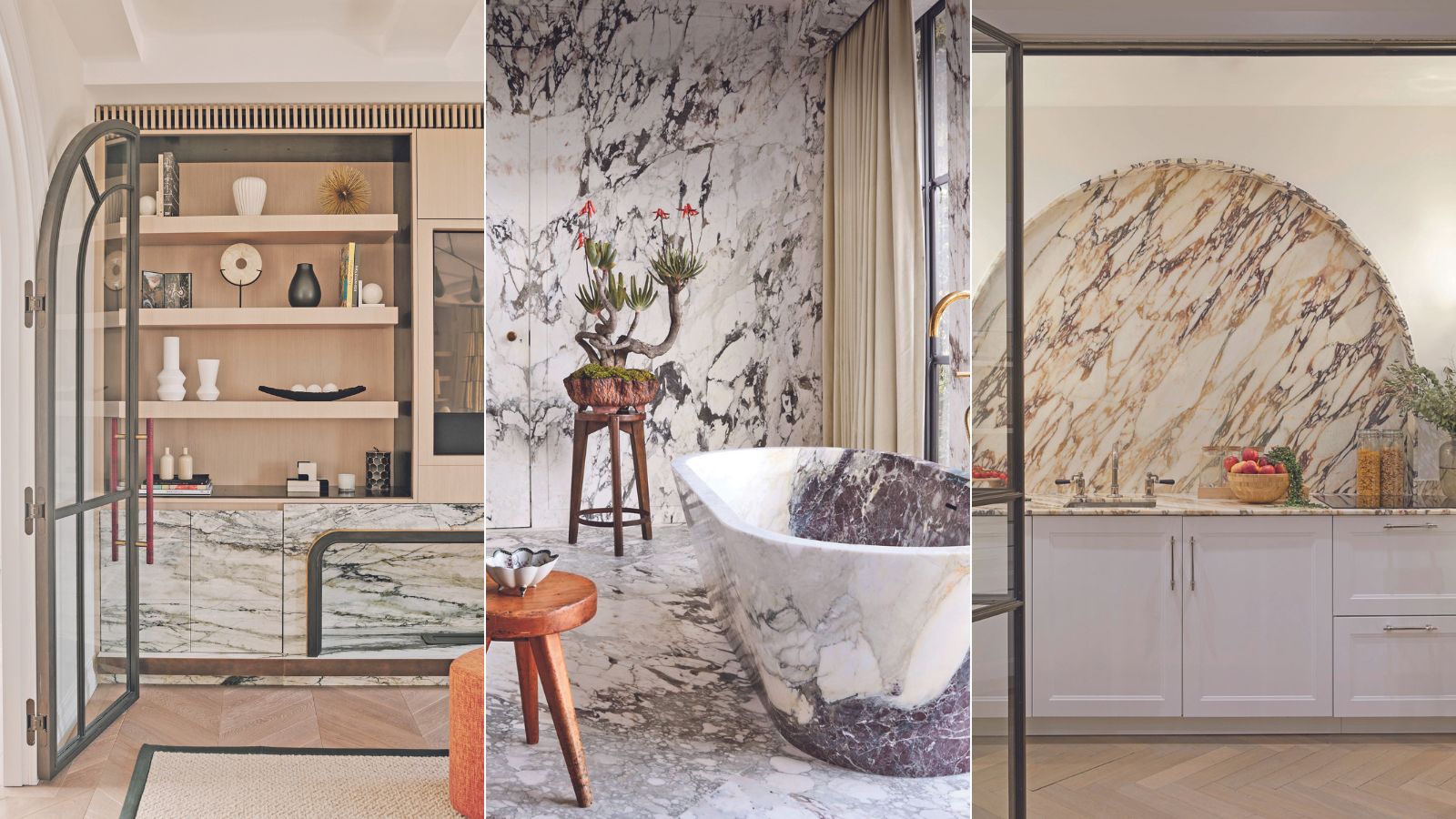
- 1. Combine colors for visual drama
- 2. Use marble to create a focal point
- 3. Exaggerate scale for a contemporary feel
- 4. Upscale storage with marble
- 5. Create eye-catching detail with marble
- 6. Give a home bar a luxe look with stone backsplashes
- 7. Create dynamism with marble's natural veining
- 8. Line a pantry with marble – and show it off
- 9. Create contrast with a marble island
- 10. Choose monochromatic marbles for a timeless appeal
- 11. Color drench with marble and paint finishes
- 12. Mix and match marbles, floor-to-ceiling
- 13. Create a niche with marble
- 14. Use stone slabs for playful shapes
- 15. Frame a space with stone
- 16. Use subtle traces of marble for eye-catching detail
- FAQs

Decorate a home with marble and you will create a glamorous appeal that's also packed with texture and natural colors. It's irresistible. But where to start with a stone that epitomizes the quiet luxury trend so popular currently?
‘I choose the marble before anything else in the room and then the scheme evolves from there,’ says interior designer Sarah Southwell. ‘I then pick out colors and textures to create a scheme that complements the marble. Then you need to decide if you wanted it honed (matte), which I prefer, or polished (shiny), the type of edge and the thickness. I normally go for 0.7in as it saves on cost and still looks great.’
When working with marble (or, indeed, onyx), the most important thing is the slab selection, adds Karen Howes, co-founder of Taylor Howes – she recommends visiting the stone yards in Italy to hand select slabs.
Marble is more versatile than many people realize, believe Angus and Charlotte Buchanan of Buchanan Studio. ‘We love to use it to elevate details and touchpoints around the home such as on a mantelpiece, or on a shelf,’ they say. ‘We also use offcuts for displaying objects such as on a coffee table.’
Another aspect of its versatility is that it can present as traditional and yet also modern. Karen says her team love to use marble ‘in every project’ in conventional ways – for kitchens and bathrooms. ‘But we also like to use marble in more creative and abstract situations such as within furniture, bar fronts and the backs of bookcases where pieces are thinly cut and backlit.’
Here, we show you how to decorate and design with marble and other natural stones flooring types.
Designing with marble and precious stones
There’s no need to only use one type of marble or precious stone. ‘We love the organic feel and pattern of marble and like to try, as long as they are tonally similar, to mix marbles for a great effect,’ says Victoria Gray of Olivine Design. ‘Recently we used honed marble for a bathroom floor then a darker, polished marble for the washstand to create impact – it also allowed us to be creative with the window and wall treatments.’
1. Combine colors for visual drama
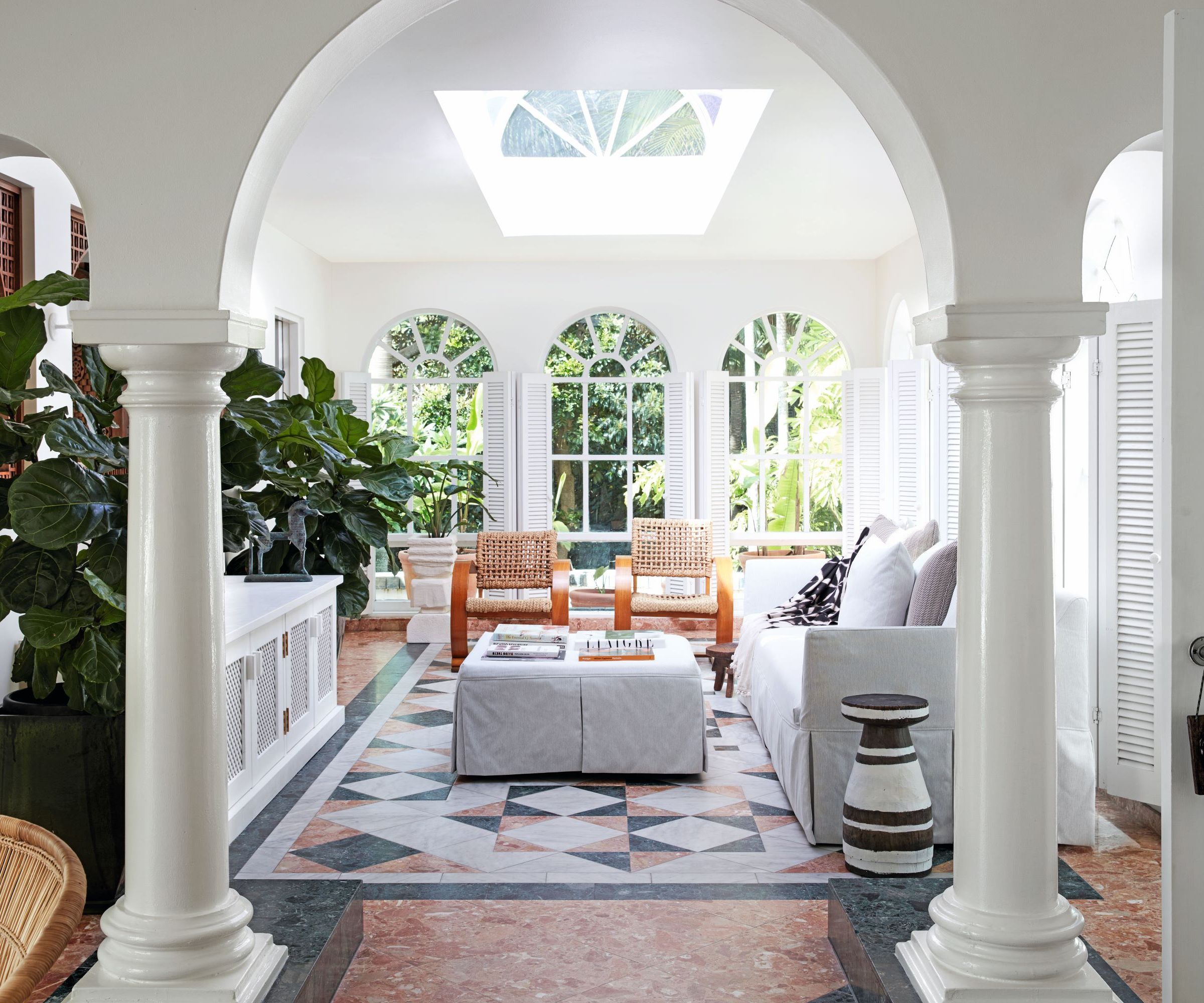
Stone has been used as a decorative material for centuries yet with a fresh approach, it can feel surprisingly contemporary and relevant in a modern setting.
When decorating with colored travertine floors, the leading Australian interior designer Tamsin Johnson employed a playful pattern for the redecoration of a hotel in Sydney’s Byron Bay.
When floors are strong in design, pull back on the other details to allow the floors to do most of the talking. Here, Tamsin conjures an eclectic look that leans on natural fabrics and a muted monochrome palette with custom coffee tables and unexpected artwork.
2. Use marble to create a focal point
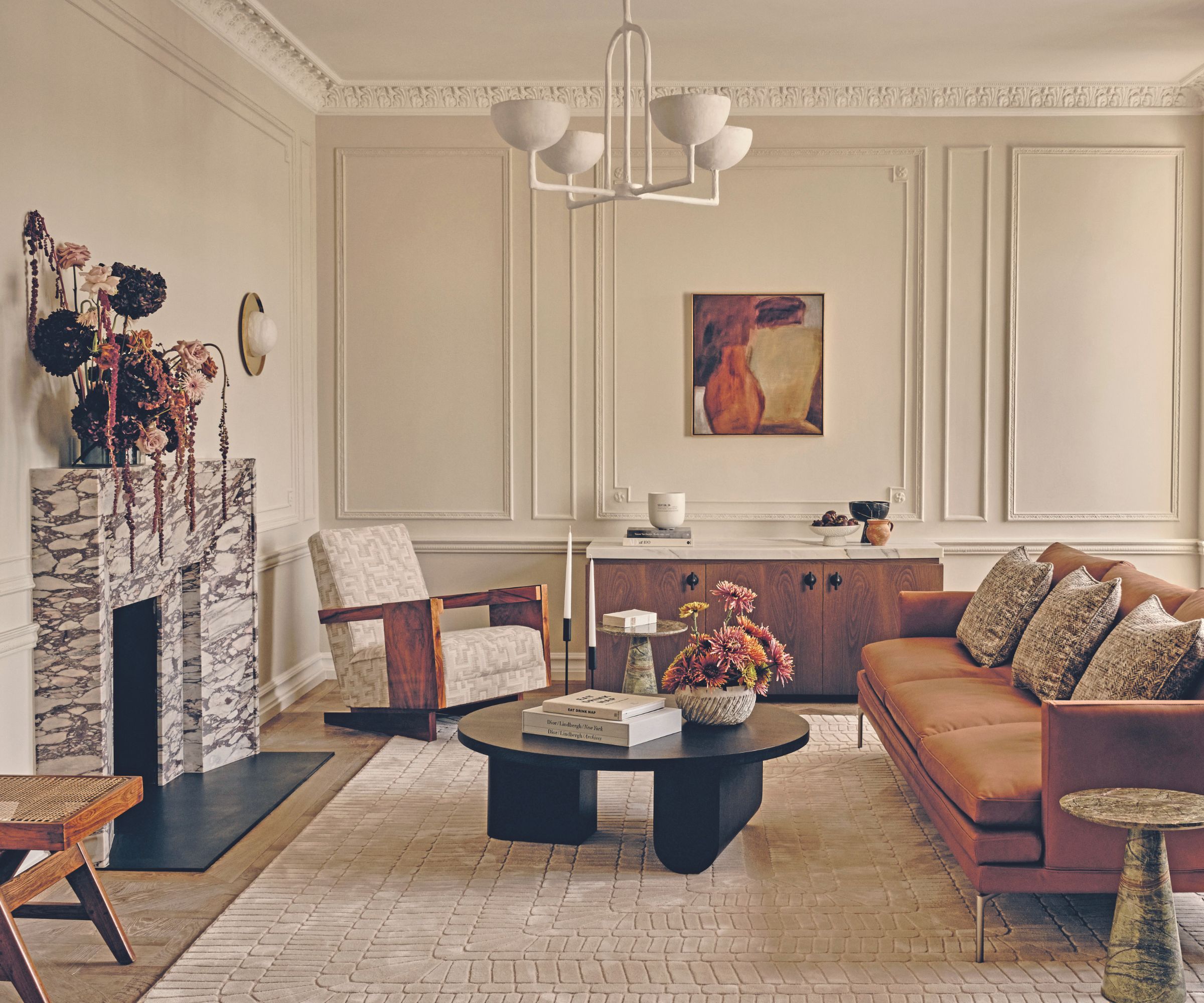
Both the type of marble and the way it is used in a room will have an impact. A classical design in a pale stone will look traditional while a stronger color will make a statement. Looking for fireplace ideas? This Calacatta Viola marble fireplace provides a fun, unexpected feature.
‘It draws in the eye and adds warmth without dominating the space,’ says Edo Mapelli Mozzi, founder of Banda. ‘It’s a deceptively long, previously featureless wall in one of the most important social rooms of the house and even with the panelling we added and the sconces, the wall needed something with scale, depth, a tactility, boldness and a practical use. We were thrilled when the client went with this option, it was absolutely the right choice.’
3. Exaggerate scale for a contemporary feel
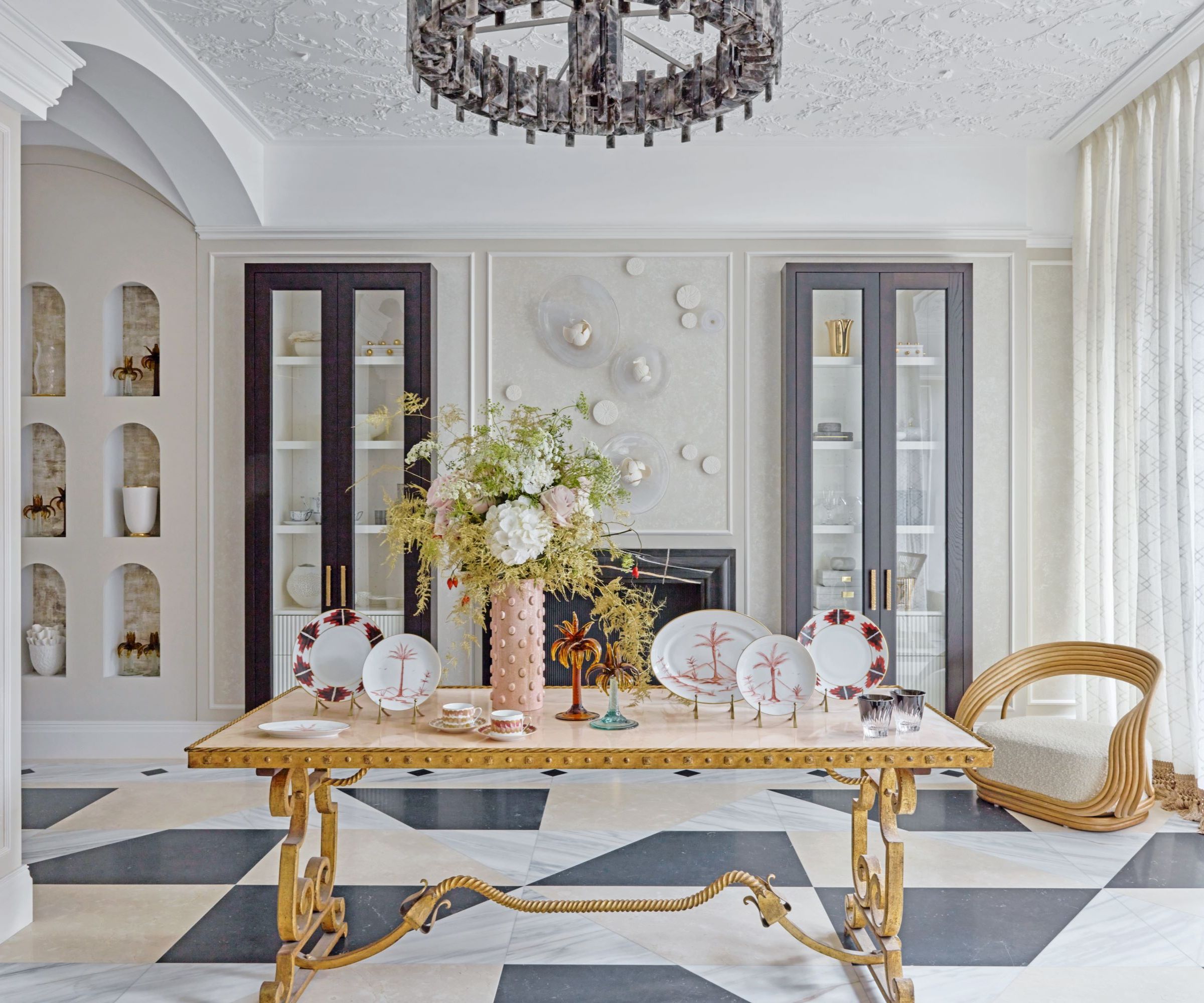
Intricately patterned mosaic-like marble floors are typically found in palazzi in Venice and Rome. Here, it wasn’t until the 1930s that marble entered the domestic setting when wealthy homeowners started to copy the interiors of the smartest hotels.
Using a larger scale approach has the effect of making the flooring more contemporary in nature as demonstrated in this scheme.
‘The interior concept was to imagine an Italian palazzo where Bona Dea the goddess in ancient Roman religion would entertain,’ says Georgina Wood of Studio Clementine who worked with McLaren Excell on this project.
‘I researched and was inspired by patterns from this era and created a modern custom pattern for the main floor.’
The mix of marble is Nero Marquina, Crema Marfil and Bianco Lasa.
4. Upscale storage with marble
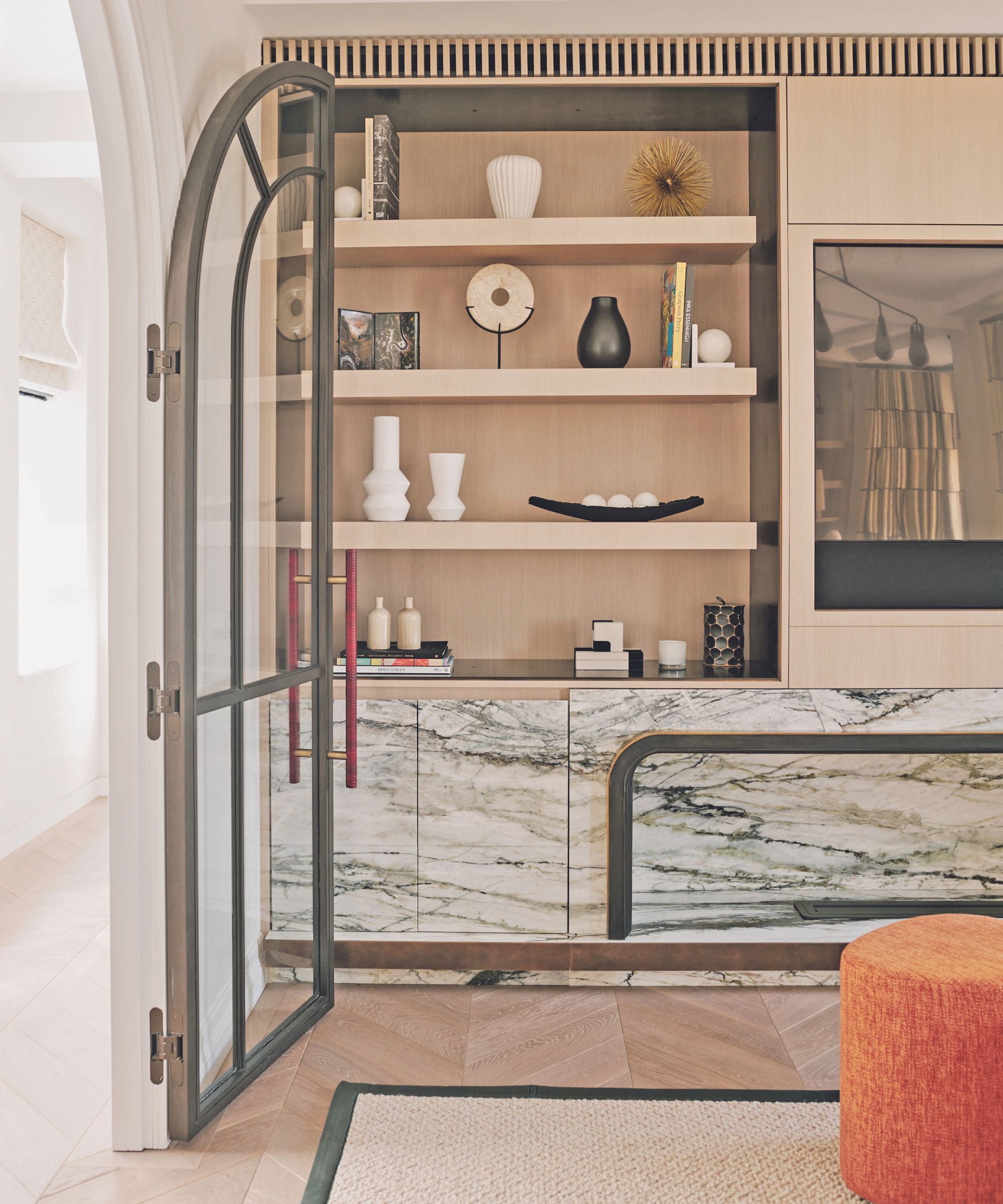
Sometimes just a touch of marble will do to elevate a piece of bespoke joinery. At this point, consider applying a veneer to some cabinetry or shelving. A veneer is made of combining a layer of natural stone with a thin sheet of a second material such as fiberglass, which is then installed on another surface.
‘This bespoke joinery, marble and metal fireplace wall was intricately designed to function as a very hard-working space while appearing effortless in bringing together the TV screen, feature fireplace and a blend of open and closed living room storage,’ says Deborah Bass, founder of Base Interior.
The finishes used include Calacatta Verde and Caleidolegno veneered cabinetry, which are set off by bronze details to the bookshelf and fireplace reveal.
5. Create eye-catching detail with marble
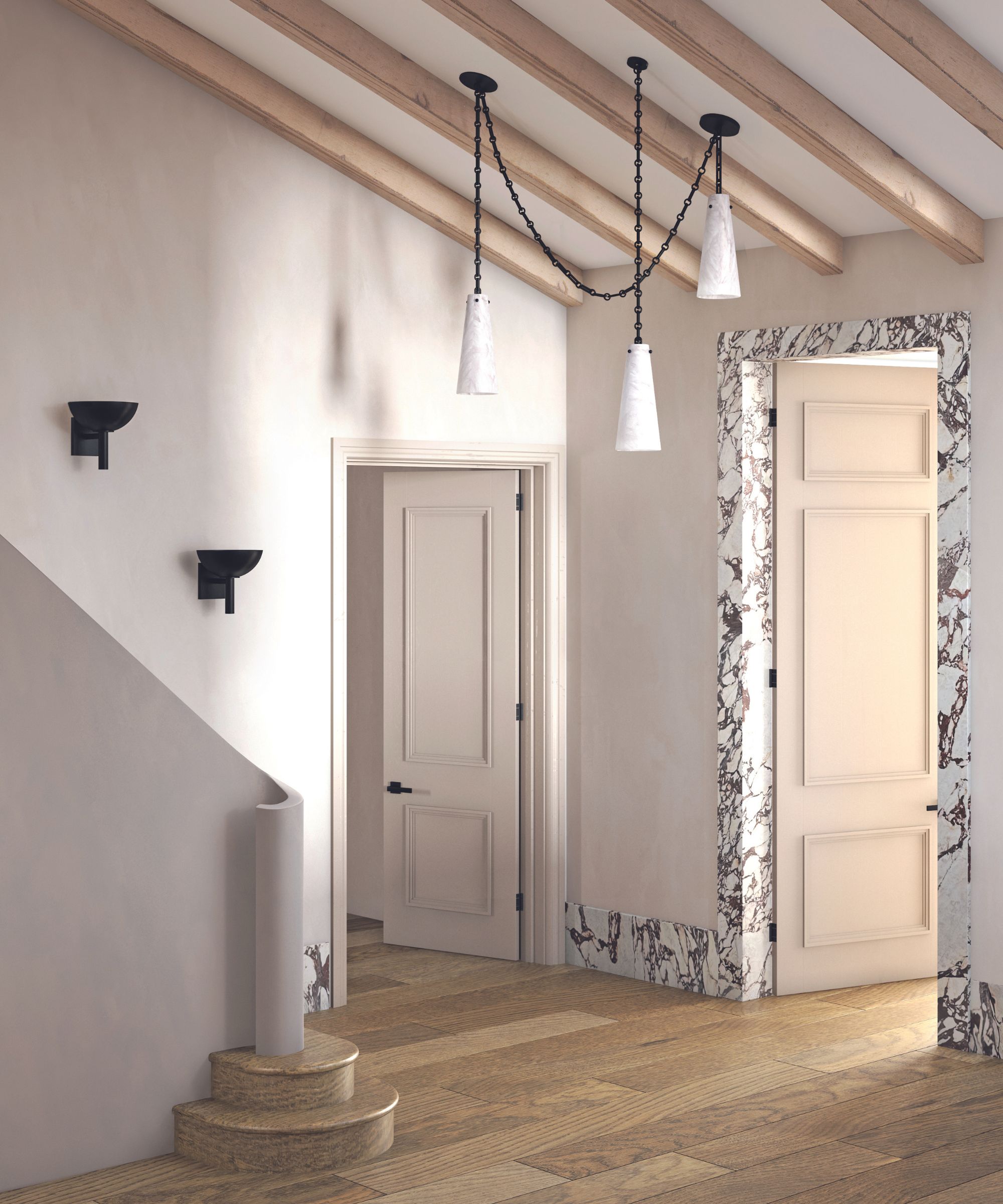
For a clean, tailored finish, consider introducing a marble finish on the baseboards and door trim. It’s an elegant way of linking rooms and adding interest, helping to bring cohesion to a space with understated luxury.
Using a very pale or barely patterned marble will look crisp and neat while a louder, more obviously veined stone will be more contemporary and eye-catching.
The team at the LA-based studio Orphan Work designed this scheme featuring their Lucca chandelier and Prato sconces. They’ve deliberately pulled back on introducing any further colors, patterns or very distinctive decorative details into the space to allow these features to stand out.
6. Give a home bar a luxe look with stone backsplashes
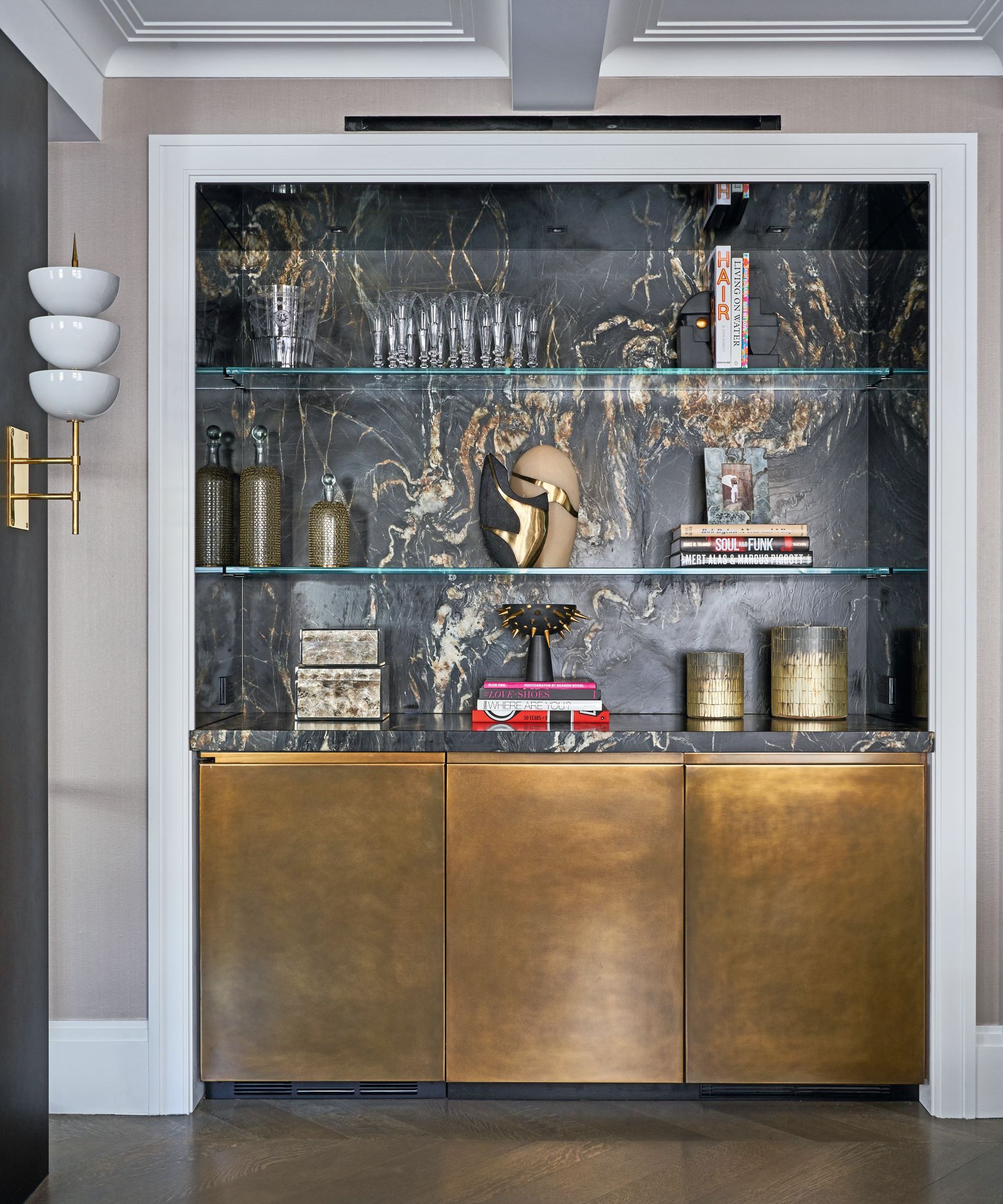
Looking for home bar ideas with a luxe feel?
‘The stone used here is a quartz called Belvedere,’ says New York City-based interior designer Michelle Gerson of this custom-designed bar for a dining room scheme in an apartment in the city. ‘We chose it because it has a sexy vibe that worked with the design and materiality of the bronze cabinets. Quartz is also a great option because it doesn’t stain or etch.’
We have a guide on cleaning white quartz countertops to ensure they stay looking as good as new.
7. Create dynamism with marble's natural veining

An arched kitchen backsplash adds an organic shape, breaking away from the straight lines and sharp corners that often dominate these spaces.
‘We chose a curved splashback as this helps push the boundaries for what is often seen as the “correct” shape of joinery,’ says Noor Charchafchi, CEO of Celine Interior Design.
The Calacatta Breccia backsplash, which is in the same stone as the countertop, adds a focal point to the room – the veins of the marble also transcend into the palette of the wider area.
8. Line a pantry with marble – and show it off
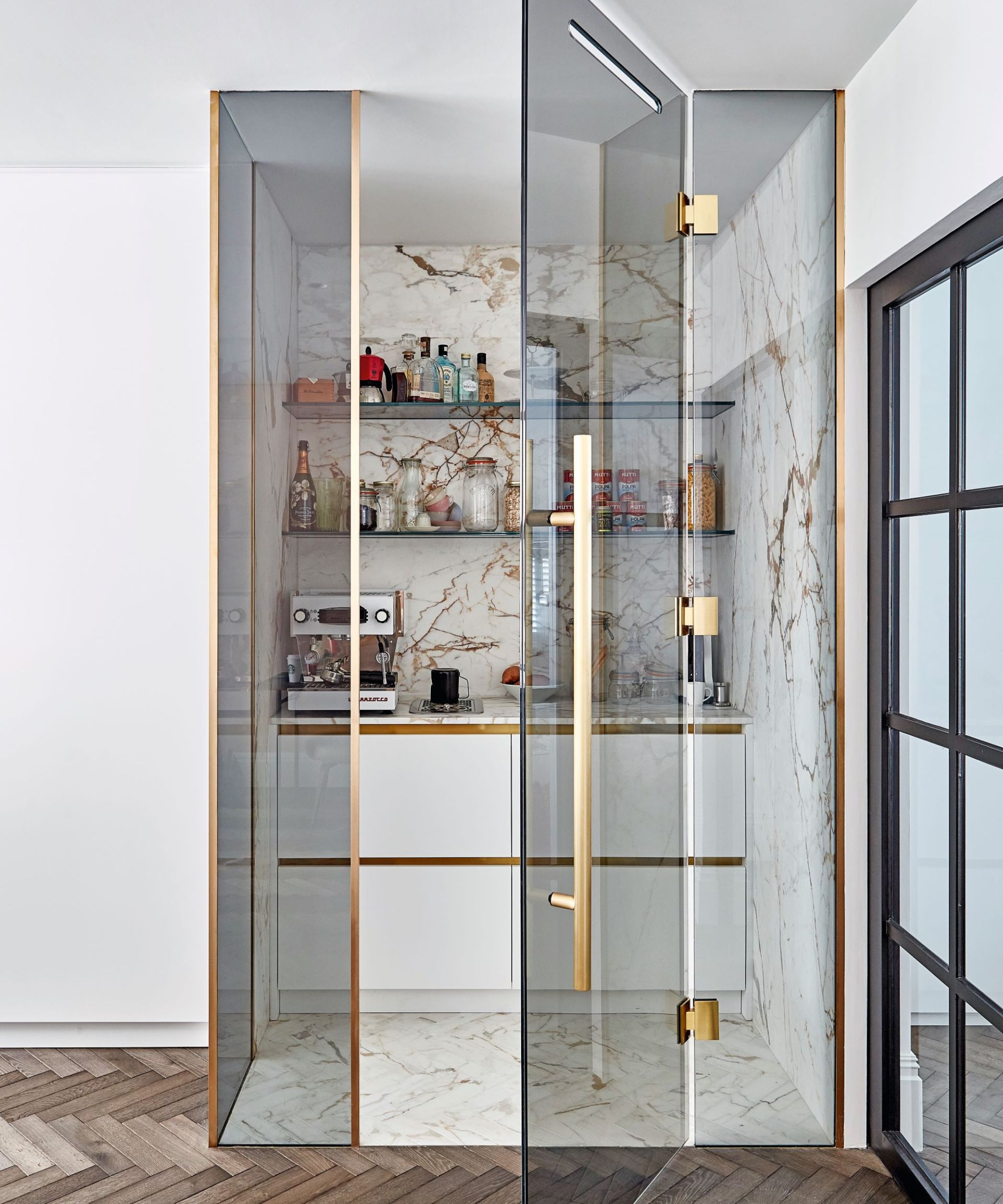
Instead of taking an all-over surface approach in creating a marble kitchen, consider using marble more sparingly to create an area of distinction or subtly zone a space for a separate use.
‘We talk a lot about creating wow moments in a kitchen,’ says Magnus Nilsson, lead designer at Blakes London, who carved out a space for a breakfast station within the wider kitchen of a house in west London.
‘A wow moment should be a place or detail that draws the eye and leaves a lasting impression – ideally something different and unique. Here, it doesn’t get more wow than a smoked glass breakfast station with glamorous brass accent details and beautifully veined floor-to-ceiling marble.'
9. Create contrast with a marble island
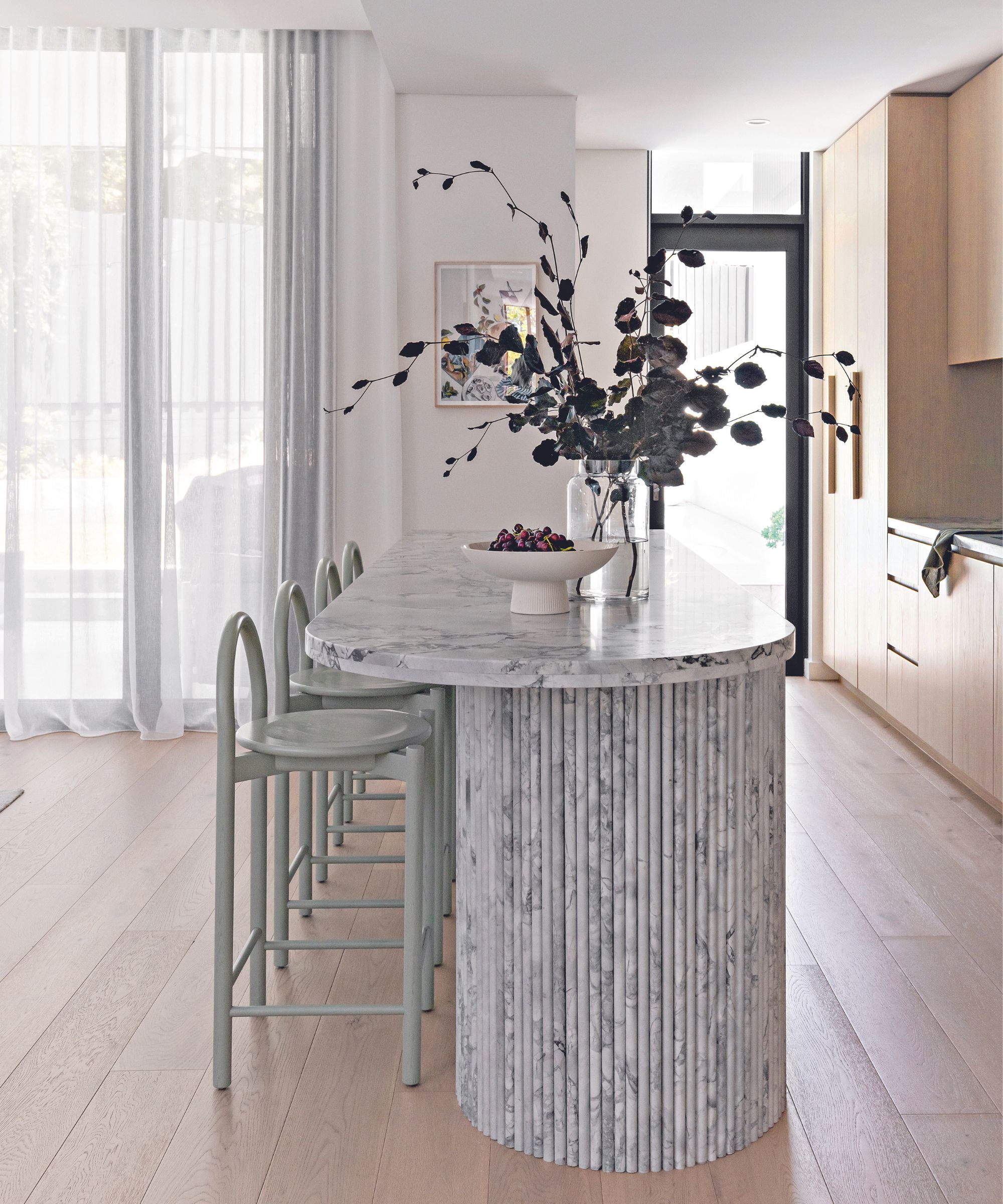
Most people will be tempted to commission marble pieces as flat surfaces but fluting and reeded details are increasingly being used to break up an otherwise seamless surface. It introduces both a visual interest and a tactile finish to a kitchen or bathroom and picks out the veining of the stone in a way that isn’t replicated when flat – much like the pattern revealed only in the folds of a curtain.
‘Adding a touch of elegance and sophistication within this kitchen, we designed the curved kitchen island bench to feature fluted Dolomite marble,’ explain Leah and Fliss Pitman, co-founders of the Australian studio Bone Made. ‘We absolutely love this detail.’
10. Choose monochromatic marbles for a timeless appeal
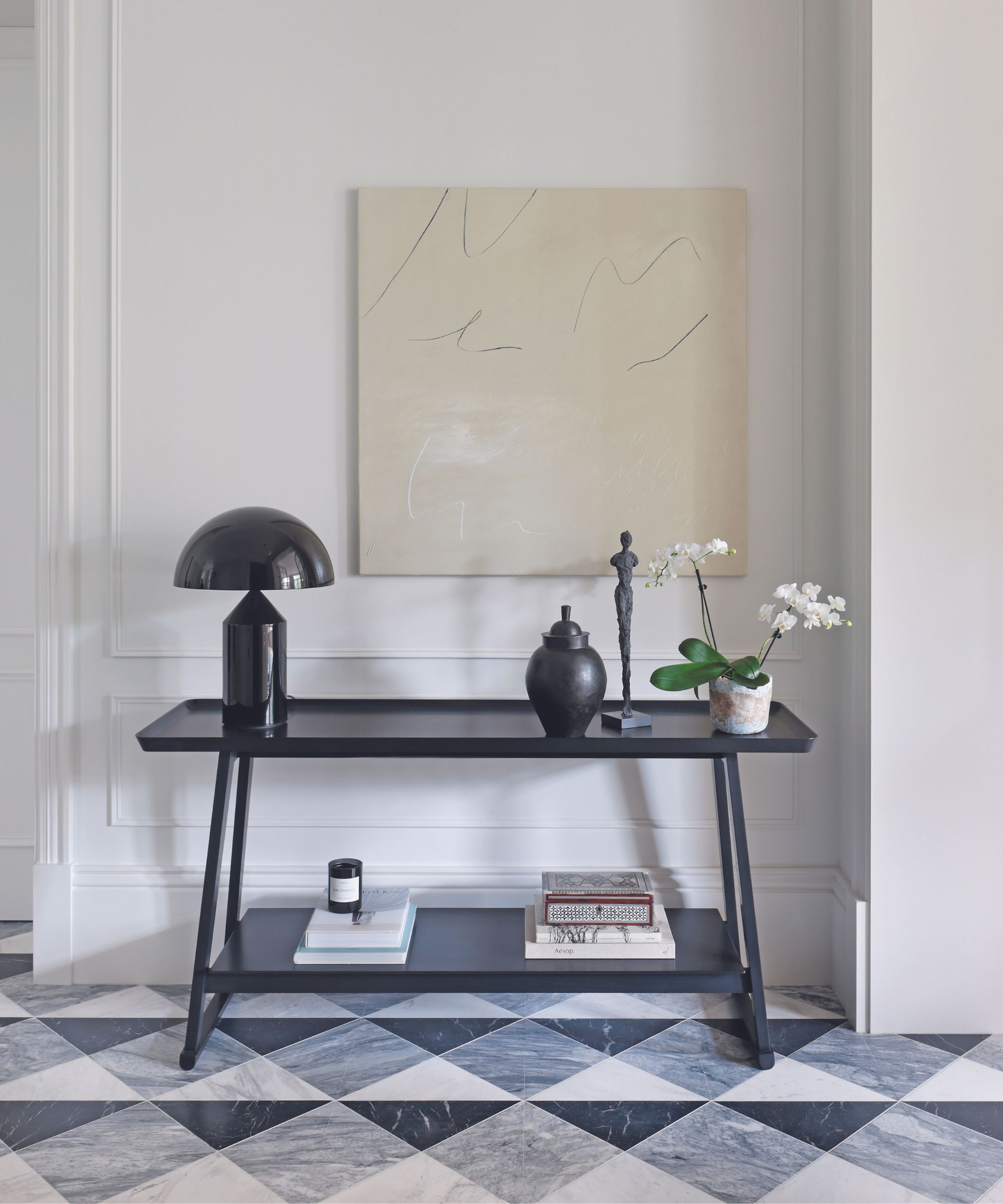
Monochromatic marble floors, while an investment, add a sense of glamor and timeless luxury to a room and are particularly attractive in an entrance hall where they set a tone for the rest of the house.
The entryway floor for this Victorian mansion block apartment in London was conceived by architectural design and interior design company De Rosee Sa. It’s laid in a black and white geometric pattern, cut from three different marbles – this floor then leads to an oak herringbone one that runs throughout the living spaces.
‘Most of the property’s original features had been lost so we inserted new details that felt sympathetic to the existing architecture,’ explain the team. ‘The beading and panelling on the walls were selected to accentuate the proportions of the space.’
11. Color drench with marble and paint finishes
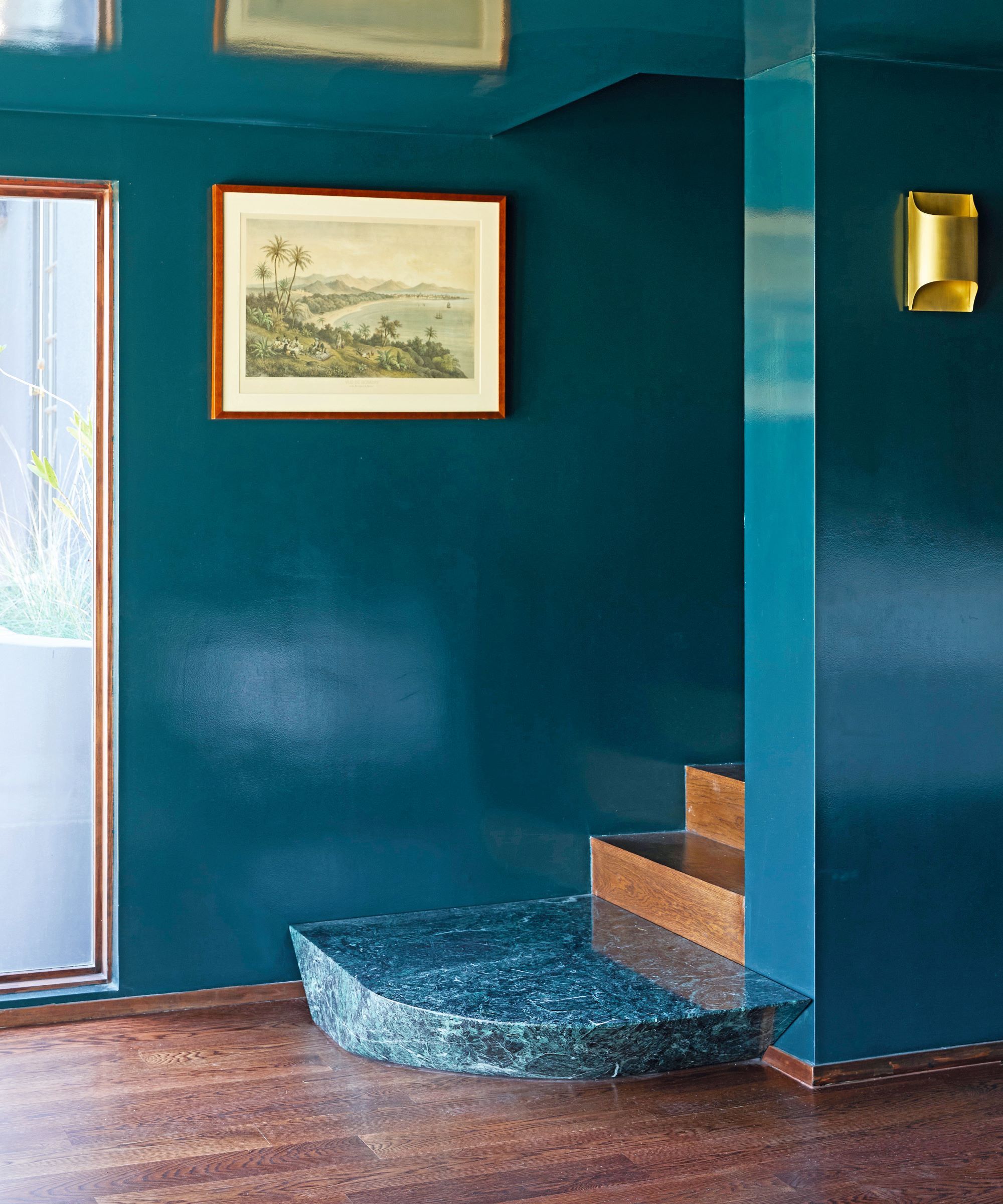
Marble stone slabs in lieu of a bottom stair create a strong sculptural (and functional) design statement.
‘The bottom stair at our Dillon house project was hand-carved by Art City Studios with design direction by Satya Bhabha,’ explain the team at Laun Los Angeles. ‘We love an unexpected architectural moment.’
The change of material allows a space for contemplation which sets the tone for the next area of the house. When going down this route, they recommend carving an interesting edge to reveal the depth of the material. Swapping the base from wood to stone will stand it in good stead for years to come – as the first, or last, on the run of stairs, it tends bear a considerable amount of weight.
12. Mix and match marbles, floor-to-ceiling
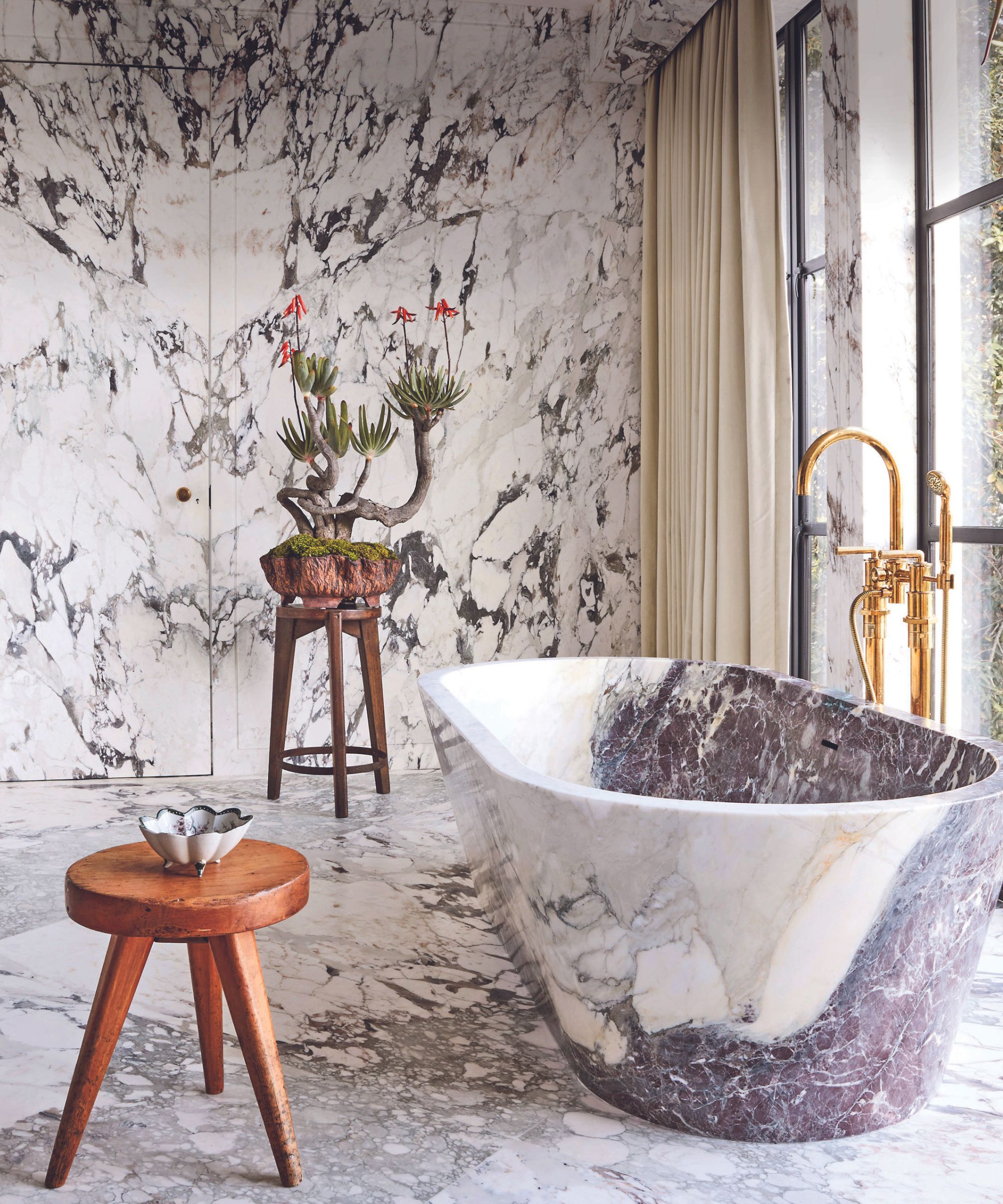
Using marble as a single floor-to-ceiling surface in a bathroom is timelessly elegant – and spectacularly luxurious. The practice dates to the Romans, who created marble bathrooms and public rooms in marble.
This bathroom by LA-based designer Jane Hallworth features in Barbara Sallick’s book The Ultimate Bath (at Amazon).
The dramatically veined walls and marble bathroom floor create a theatrical element to the space, which is then elevated further by the addition of a matching marble bath.
There is a point at which it is possible to overdo the use of one material, however. To avoid the space looking sterile and cold, add a warm finish in a material such as wood or metal as a subtle touch.
13. Create a niche with marble
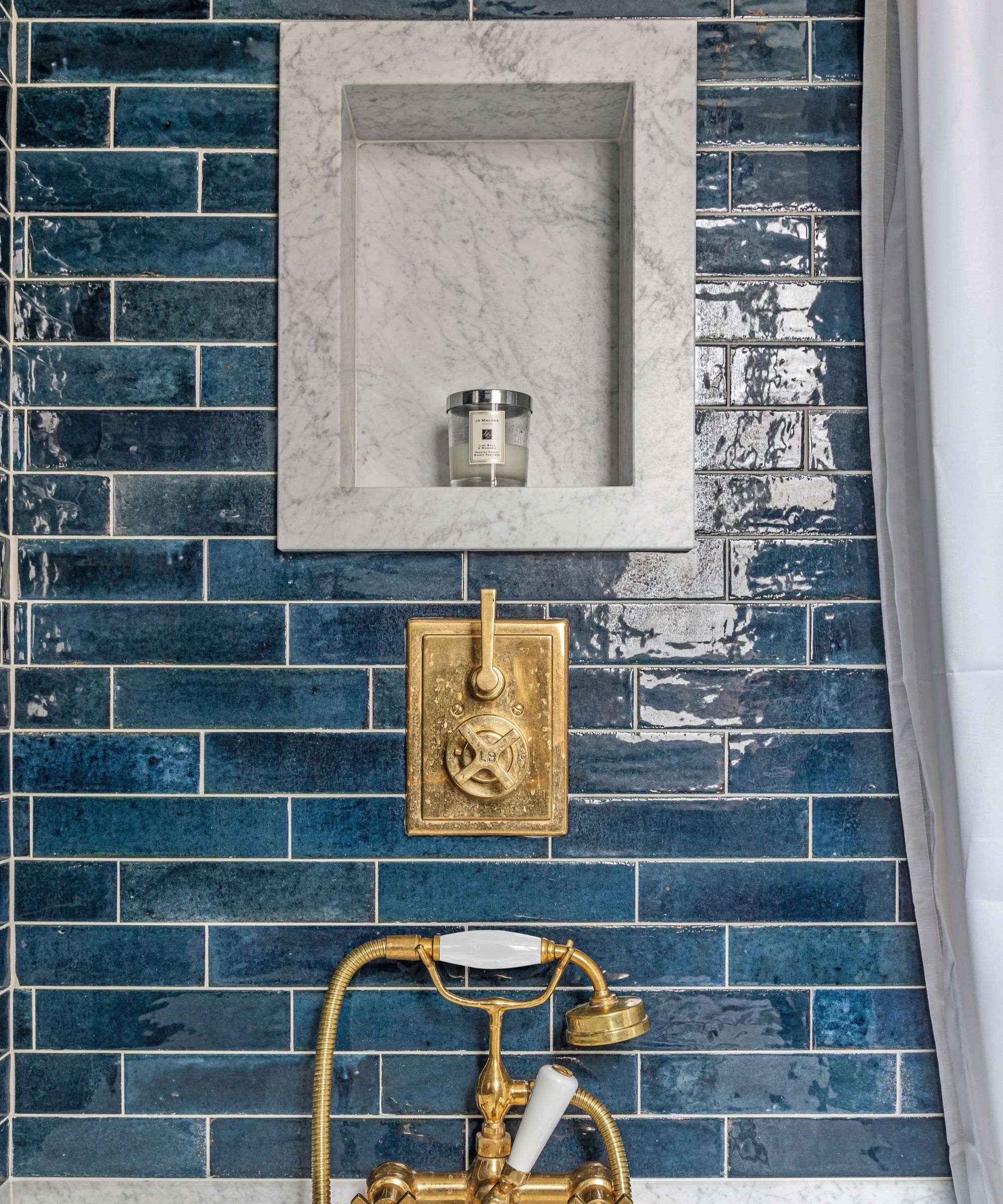
The shower niche is increasingly becoming a common sight within design-led bathrooms. While some will choose to use the same tiles for a seamless look, using another material such as marble will result in a striking feature.
‘Personality-filled, glossy denim-colored tiles reflect light around this bathroom and create a beautiful textural richness while the Carrara marble niche creates a crisp and clean feel without being remotely clinical,’ says designer Naomi Astley Clarke.
14. Use stone slabs for playful shapes
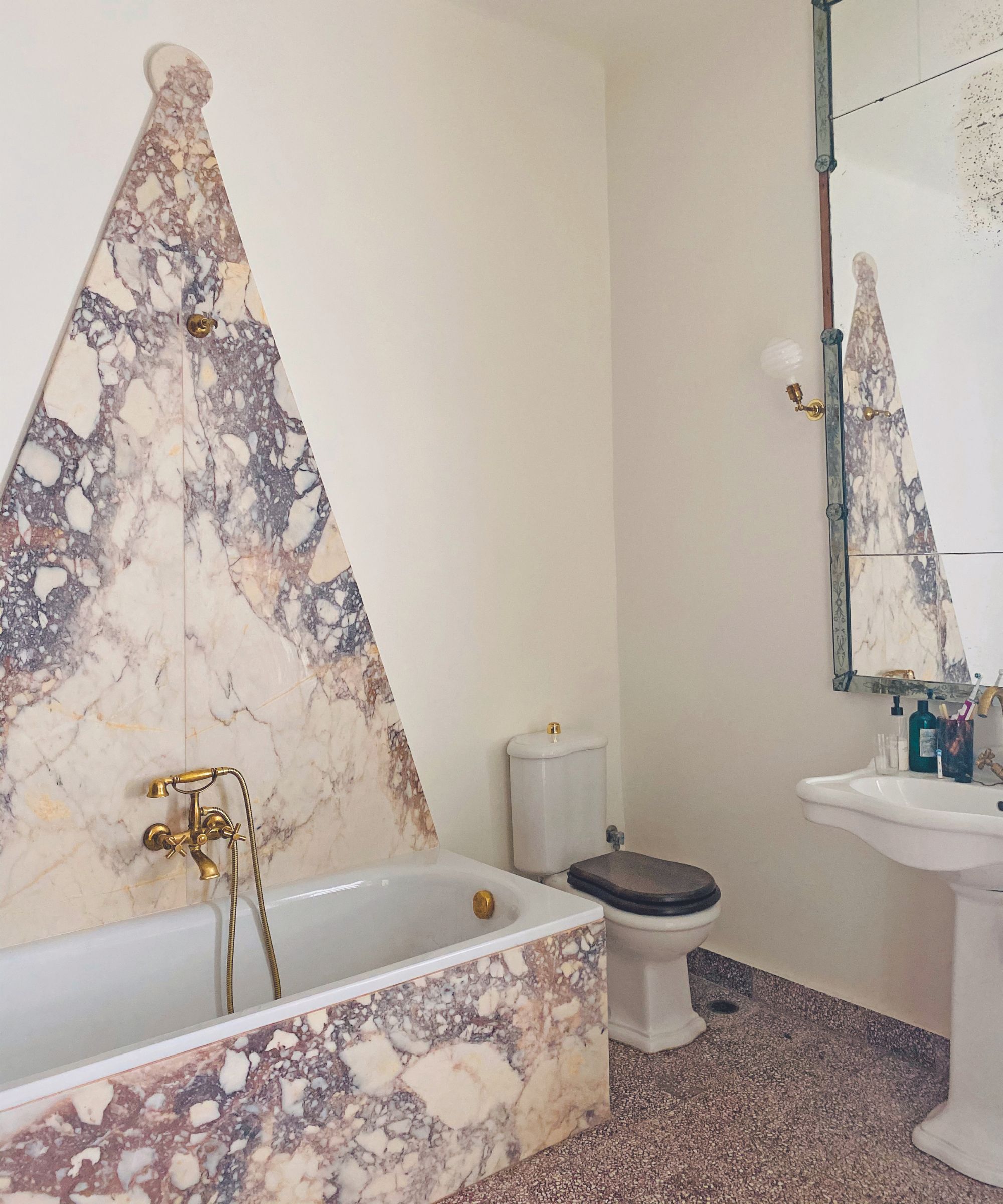
Rather than having stone quarried from fresh slabs, think about sourcing reclaimed pieces or offcuts as a sustainable approach to using marble in a design. When choosing this route, it’s likely that a specialist stone restorer will be needed to cut and polish it to the right shape and size. Be led by the organic shape of the slab when working with the stone restorer to make a stronger statement.
‘I designed this tub after discovering a few rare old slabs of a marble from the Greek island of Skyros, which is no longer quarried,’ explains the Athens-based artist and designer Venetia Sacret Young. ‘I have a fascination with Masonic architecture and how it interprets classical forms,’ she adds.
15. Frame a space with stone
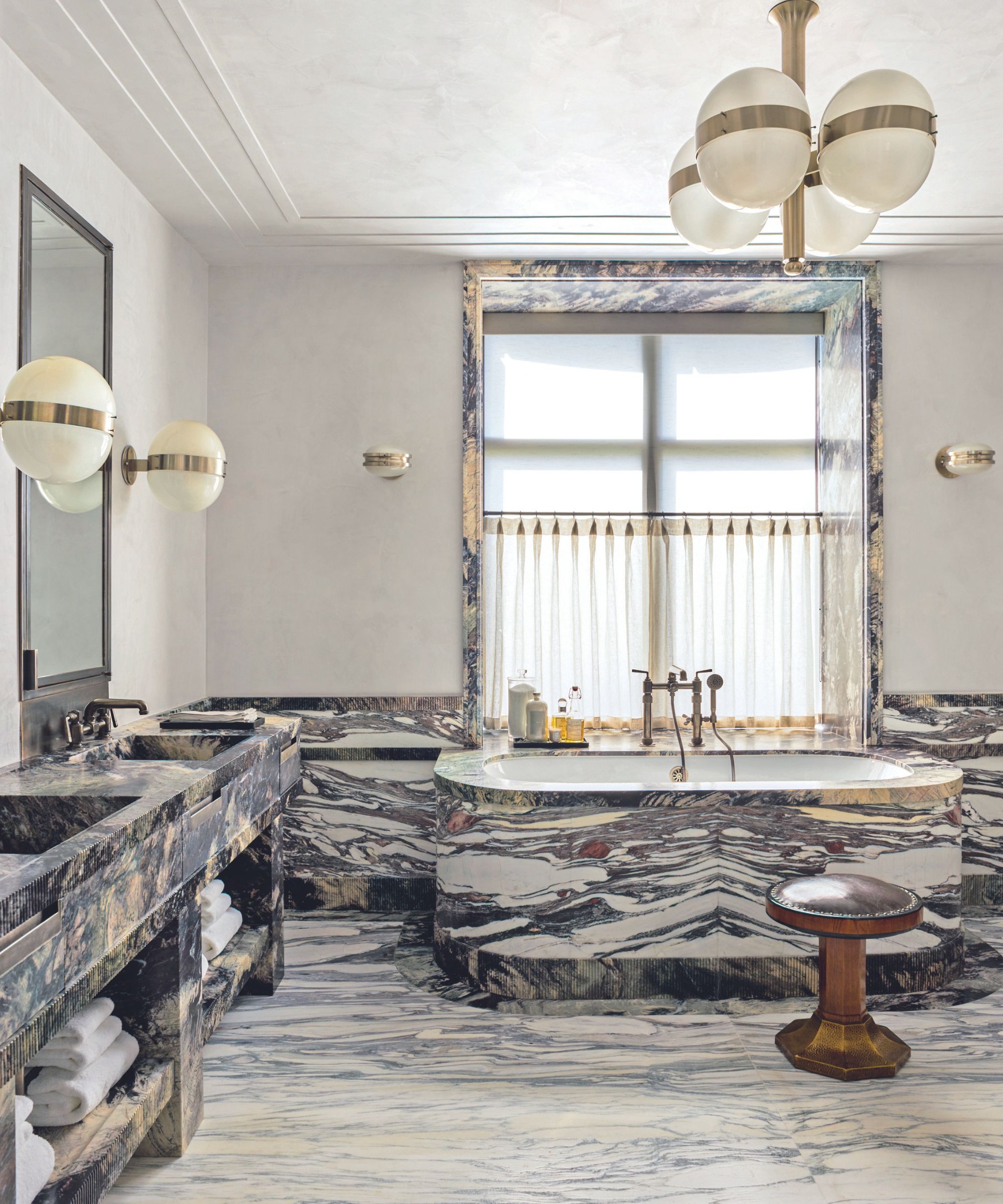
Carrying the marble details to the architectural edges of a room will always result in a cohesive and tailored bathroom. In this glamorous yet masculine scheme by architect Steven Gambrel, founder of S.R. Gambrel, for a property bathroom in Dallas, Texas, he’s embraced a selection of highly figured marbles including Purple Haze, Arni Fantastico and Fantastico Viola from Long Island-based supplier BAS Stone NYC.
Not only do they look stylish and luxurious but marble window sills and frames are the perfect material to repel water. With the proper sealant, water will bead right up and wipe clean, leaving no lasting marks that might otherwise stain painted wood. The addition of a cafe curtain at the window adds a contrasting soft note.
16. Use subtle traces of marble for eye-catching detail
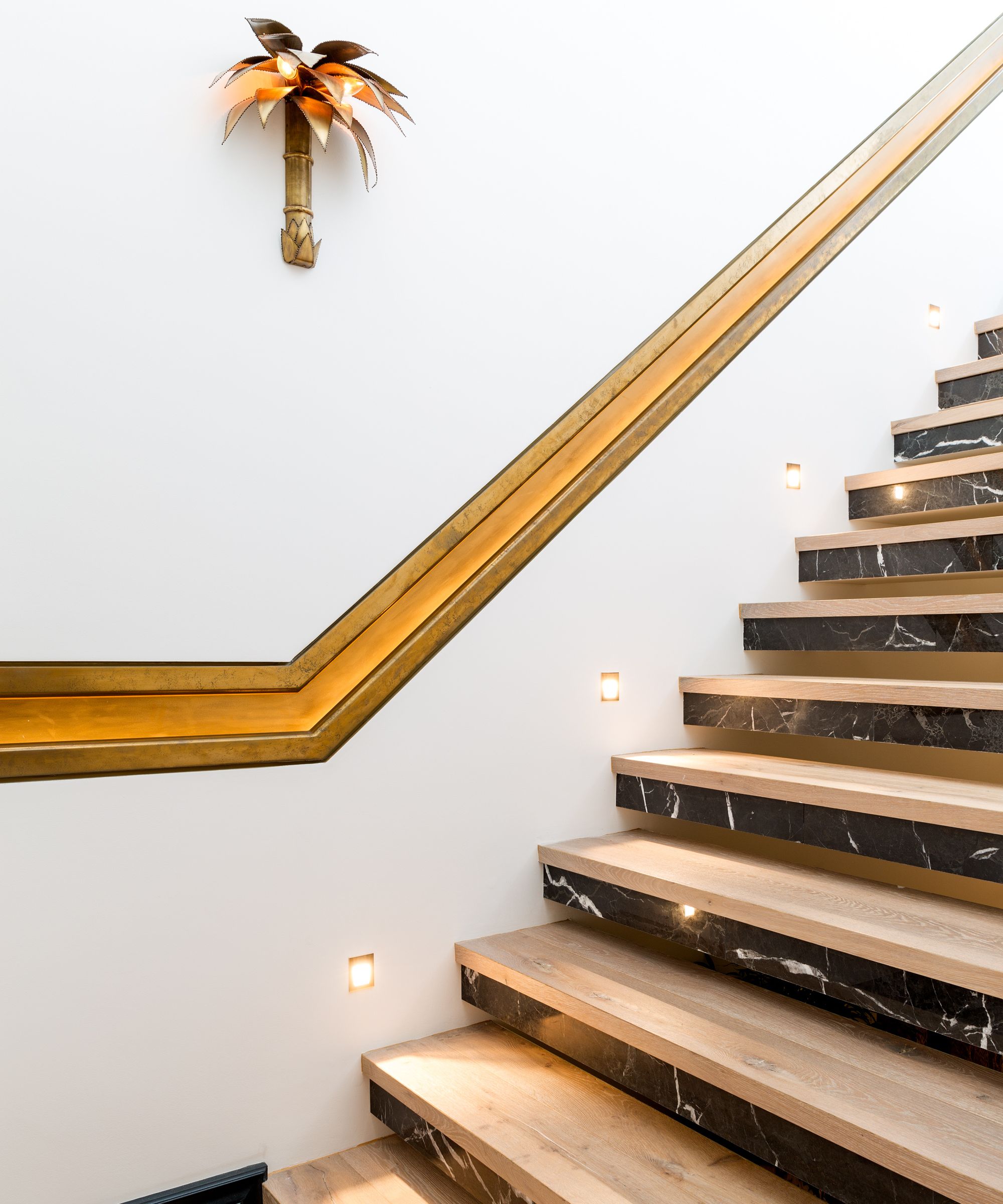
Stairs are subject to a lot of foot traffic, so durability is vital to consider when looking for staircase ideas. While most choose staircases in wood, the application of marble or detail in marble is an eye-catching solution. Not only will it meet the needs of durability but it is also a smart long-term investment.
In this scheme, Joshua Sear-Barlow of interior design studio Barlow & Barlow cut down and clad a stair riser with Nero Marquina marble tiles from Artisans of Devizes. At night, these are lit at a low level to draw attention to the detailing.
FAQs
Is marble easy to care for?
Marble is long lasting, cool to touch and anti-bacterial, making it ideal for kitchens and bathrooms. These days, it’s something of a myth that marble is a high-maintenance material – especially with advances in sealant technology seeing some manufacturers offering 10-year guarantees against stains, says Jason Cherrington, director of Lapicida. ‘Always take advice from your stone suppliers as to the correct care of the stone you have bought. Follow the instructions on the bottle of the sealer you use, but if in doubt don’t use a bleach or acid-based product – there are lots of stone cleaners on the market.’
We like Marblelife Marble Cleaner, at Amazon.
Is marble environmentally friendly?
There can be ecological concerns around the extraction of marble as it uses a large amount of water and energy in the process which also produces significant waste. If it is being shipped from overseas, there are further carbon costs to consider. Reclaimed marble is one option to try, as is terrazzo which is typically made from marble offcuts. Our terrazzo bathrooms feature has plenty of inspiration.
Lastly, recognize that the marble you order won't be exactly as seen in a showroom. 'Marble comes in a vast array of colors and patterns, but also varies so hugely slab to slab that every piece is unique, say Angus and Charlotte Buchanan, co-founders of Buchanan Studio.
Sign up to the Homes & Gardens newsletter
Design expertise in your inbox – from inspiring decorating ideas and beautiful celebrity homes to practical gardening advice and shopping round-ups.

Arabella is a freelance journalist writing for national newspapers, magazines and websites including Homes & Gardens, Country Life, The Telegraph and The Times. For many years she has specialized in writing about property and interiors, but she began her career in the early 2000s working on the newly launched Country Life website, covering anything from competitions to find the nation’s prettiest vicarage to the plight of rural post offices.
-
 Plants never to grow next to fruit trees
Plants never to grow next to fruit treesExpert advice on which plants to keep away from fruit trees to encourage a healthy harvest
By Jacky Parker Published
-
 Martha Stewart's tips for arranging daffodils are unbelievably simple and effective – it's the only flower advice you need this springtime
Martha Stewart's tips for arranging daffodils are unbelievably simple and effective – it's the only flower advice you need this springtimeMartha shows us that we can create gorgeous bouquets of this seasonal flower by simply trimming the stems and placing them in specific vases
By Hannah Ziegler Published